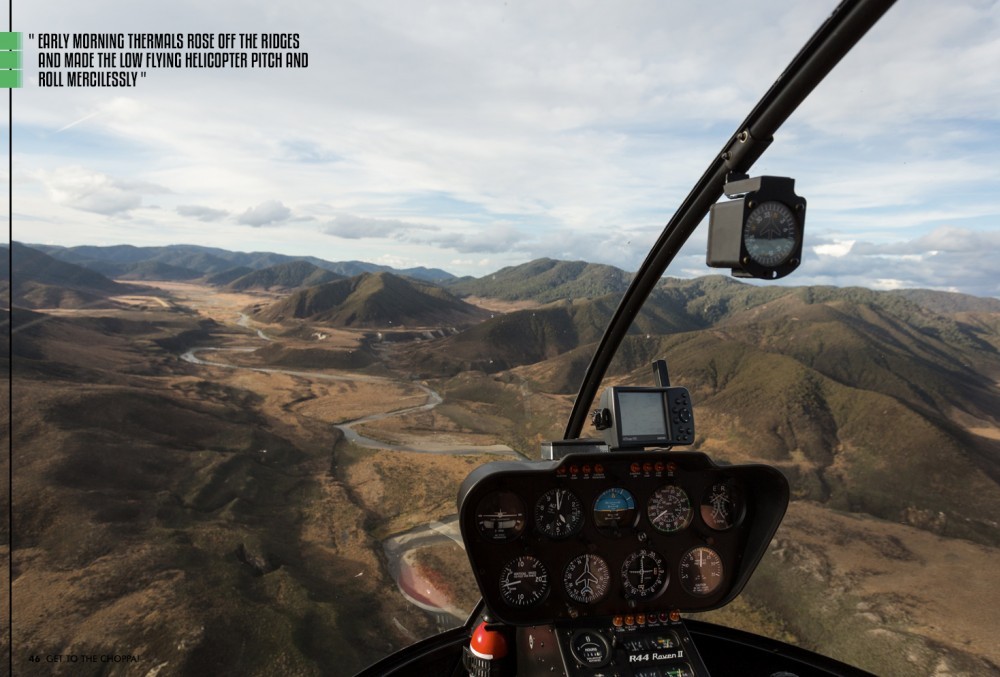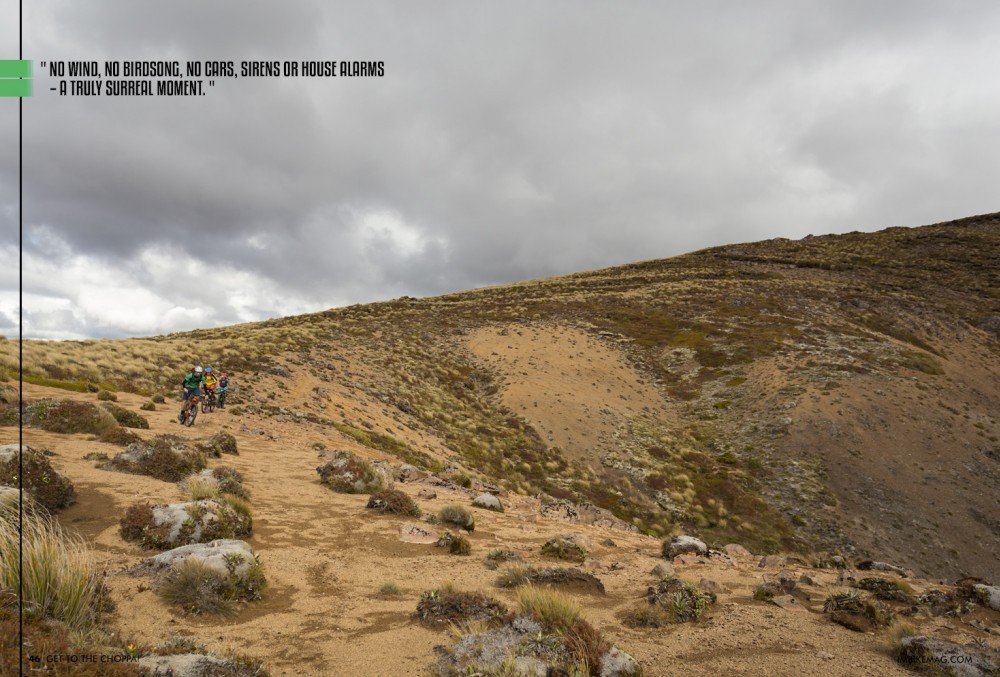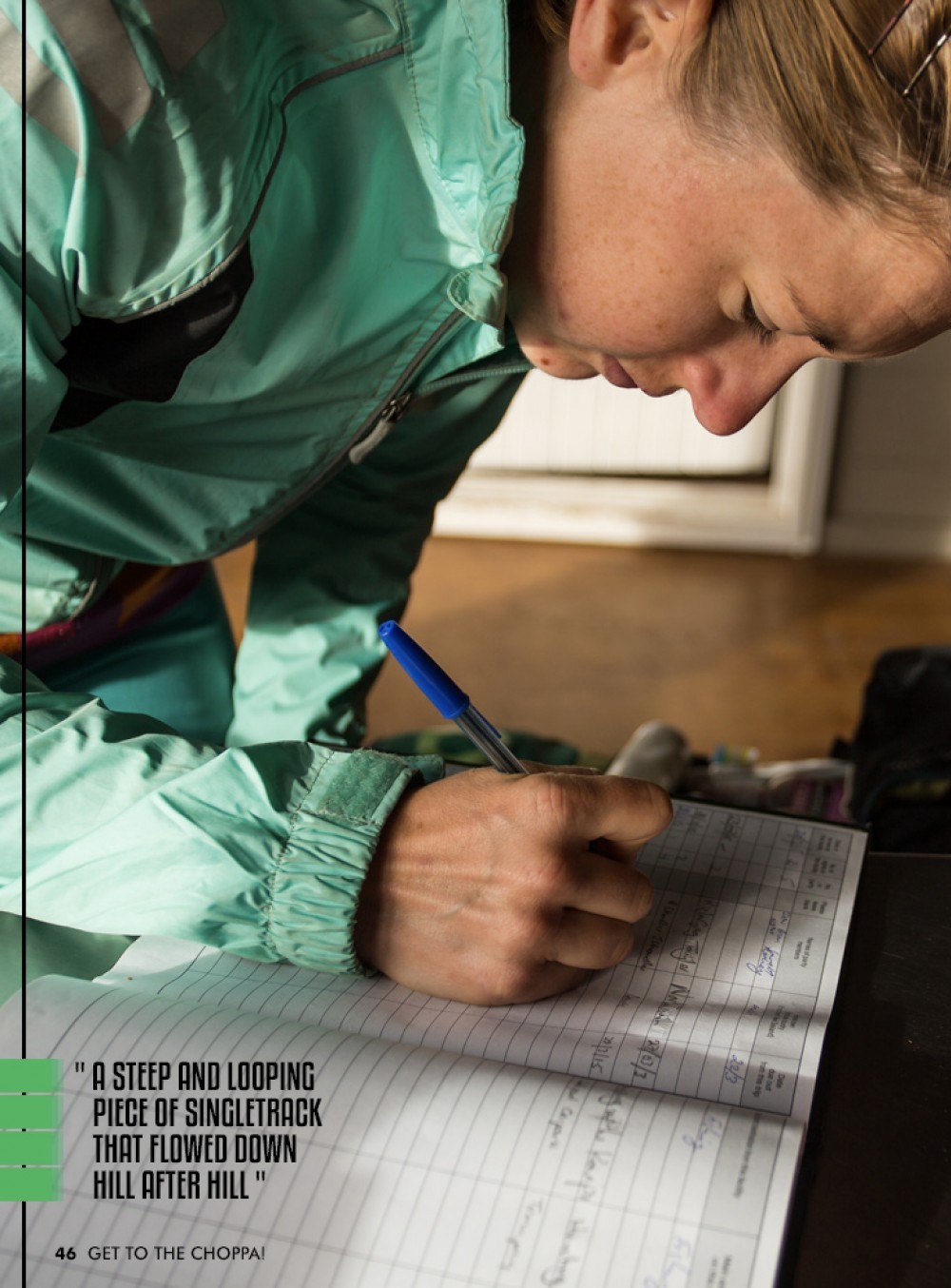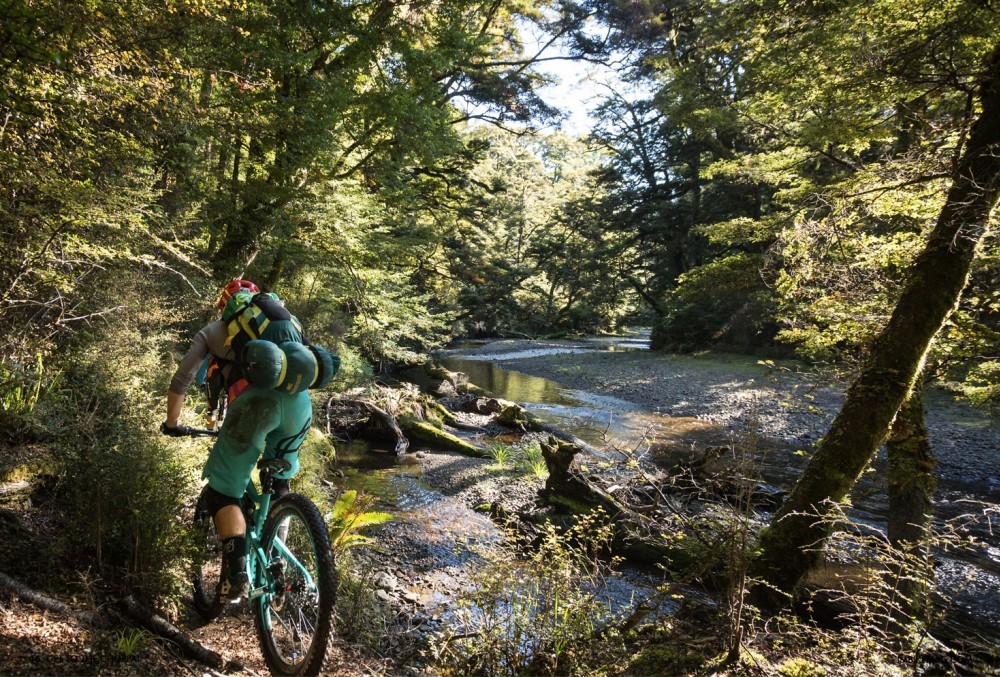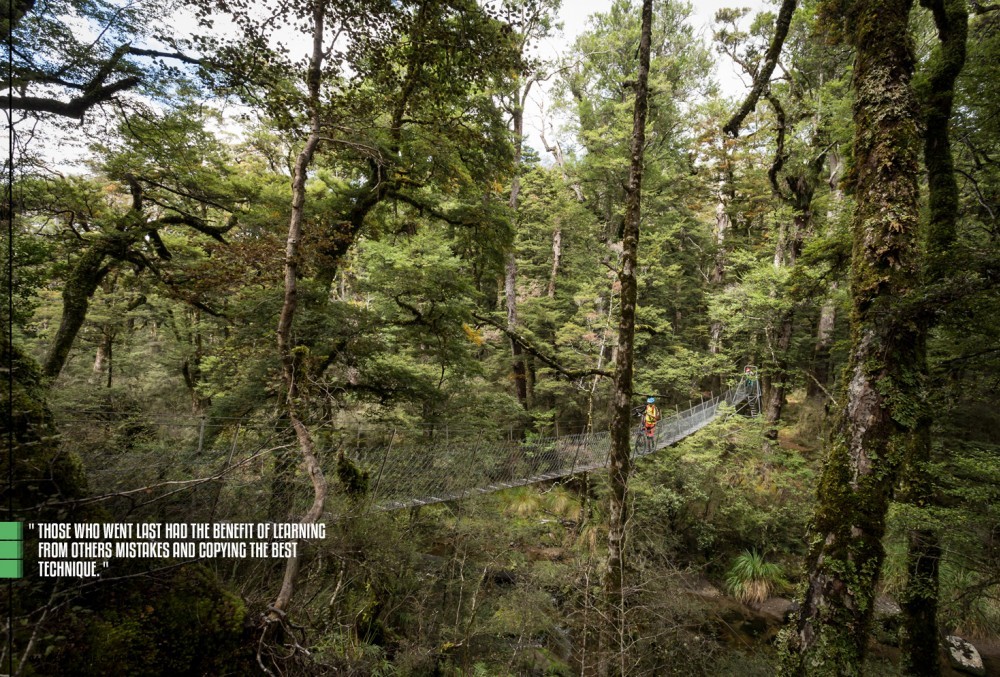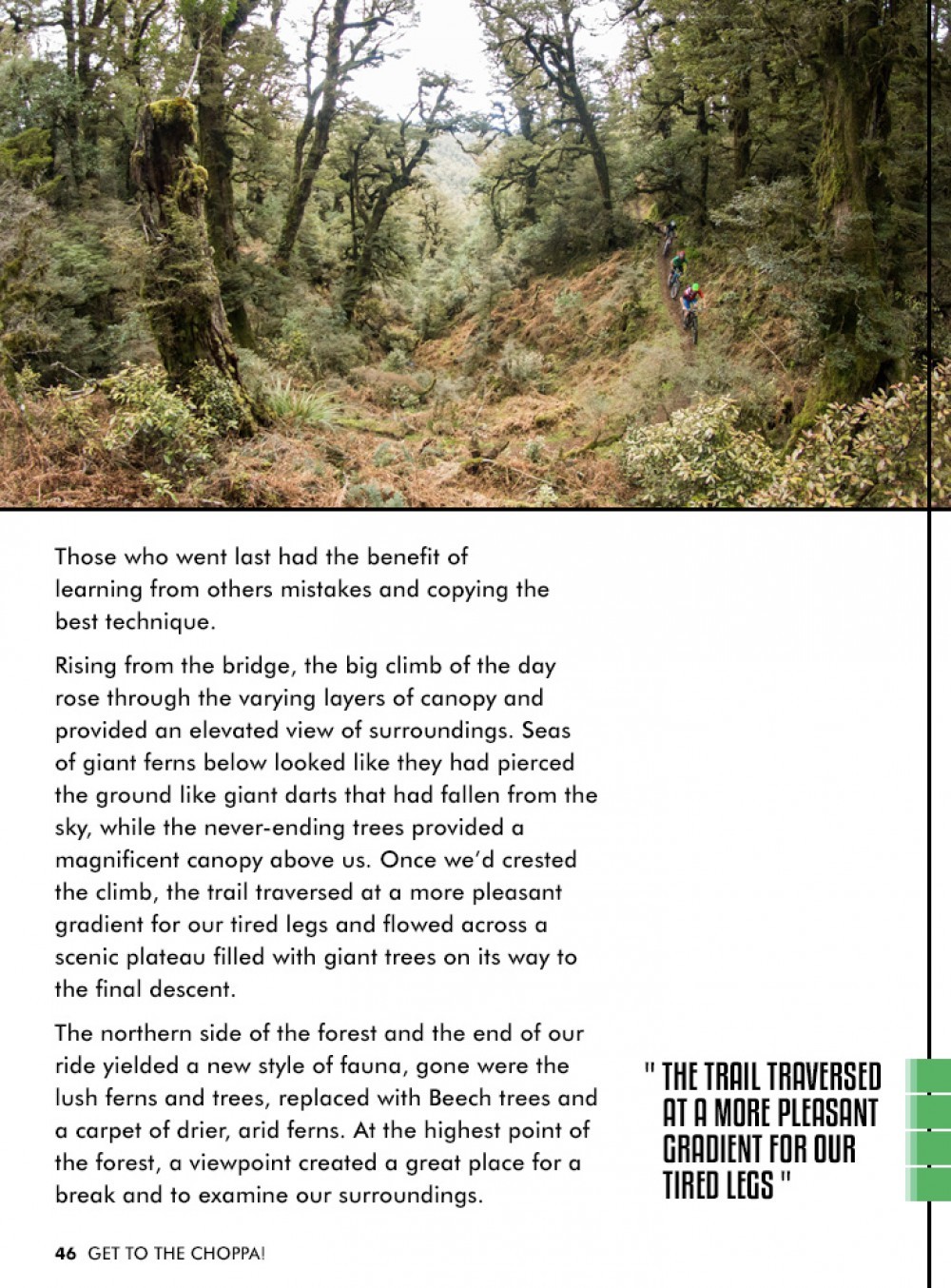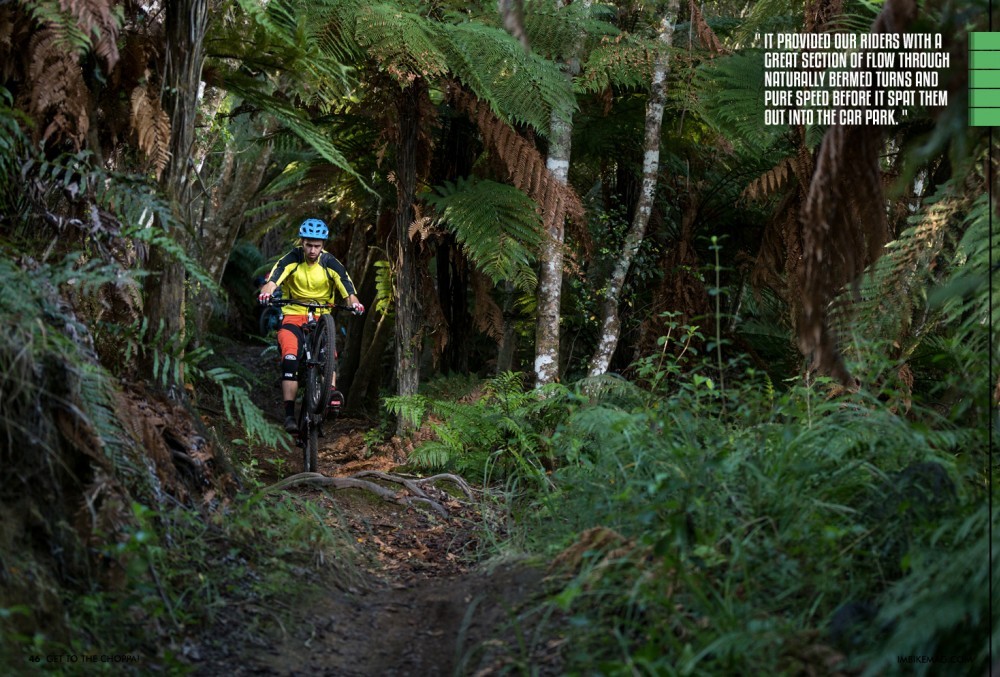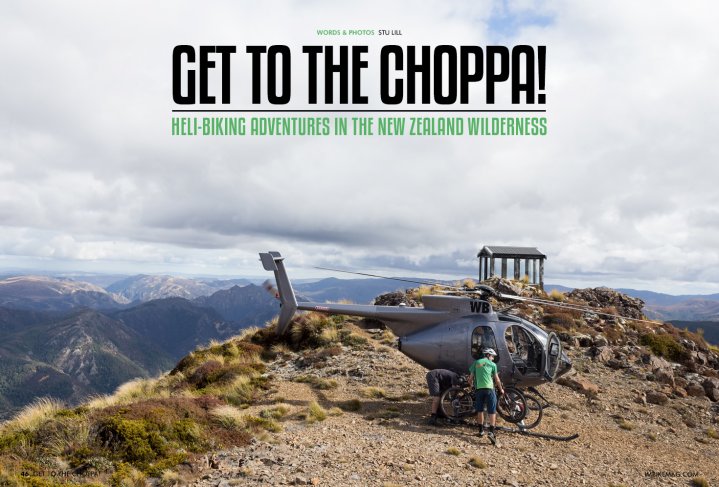
Get To The Choppa
Issue 46 / Thu 16th Feb, 2017
Nothing gets you into the wilderness quicker than a swift trip in a helicopter. Stu Lill tells the story of an epic ride into the backcountry in New Zealand, combining heli drop offs, bike packing and amazing trails.
If you’re looking for an adventure there are not many better activities than heli-biking: A one-way ticket to fresh singletrack trails and stunning scenery. Why not extend that single day adventure and grow it into something much grander, heli-biking into the backcountry and riding out through epic singletrack over two days. At least this was the suggestion from New Zealand mountain bike tour experts JustMTB when approached with the requirements for a unique adventure.
Pouring over maps with the group we highlighted a two-day journey through the backcountry landscapes of New Zealand’s North Island. A red line threading through green forests, across blue rivers and over orange contours detailed our route and the adventure for the next days. Leaving behind the lights of town we headed out west towards the helicopter base, the sun peeking over the forest just behind, as the early morning mist burned off. Bagging up supplies and overnight kit, we weighed the group in and boarded our small four-person helicopters. The external bike racks were working a treat at keeping bikes separated as we began to take off. Early morning thermals rose off the ridges and made the low flying helicopter pitch and roll mercilessly – a unique feeling for our group, most of whom had never been in a chopper before.
Gaining height gave us a unique perspective on the land below. Large rivers meandered through the dry tussock and rocky landscape beneath, sitting centre of large flood planes playing home to a variety of animal life. Our pilot Ben educated us on the convoluted history of the area, explaining about the limited access rights for the public; the unique fishing and hunting scene that thrived in the area and the lowdown on trail conditions. Luckily we were flying over these hunting & fishing blocks and far away to our mountain top haven. As we skimmed over the ridges of native forest, everything below started to look the same – with only a very few clear vantage points it’s not surprising people get lost out here without the knowledge of our local guides.
As we landed on the highest peak in the area, the group was mesmerised by the stunning 360-degree view. For these city dwellers whose previous backcountry experience had been limited to longer trail rides in the local forests, this provided a unique and refreshing experience. With rolling rocky hills one way, endless old growth forest another way and a snowcapped volcano to complete the vista, all the iPhones came out to document this wonderland to which we had transported them. Already stoked out by the helicopter experience, the second helicopter departed, it’s engine slowly faded, and eerie silence enveloped. No wind, no birdsong, no cars, sirens or house alarms – a truly surreal moment.
The remote location creates an immense difficulty of access to the area and consequently the descent from the peak is one of New Zealand’s most under ridden trails. Reminiscent of a great storybook, the trail is ever changing, starting slow, developing through the middle and finally providing a big crescendo. We dropped into the first section aptly named Shale Master, the group traversing scree slopes and rocky bluffs between singletrack corners. Watching the guys flow down the face was reminiscent of watching people ski on bikes. A blank canvas for riders to paint their own interpretation of the trail - the only parameters being some big arcing turns to stay on the mountain.
A far cry from the open rocky peak, the middle section of trail provided a very different experience as it developed from rocky shale to a ribbon of loamy flowing singletrack flowing through meadows. With no trees in this open landscape, it was possible to see a few kilometres ahead at a time and plot a course through the tussock grass that whipped at our ankles as we rode warp speed towards the bottom of the hill. At the base of the valley, there was a slight climb to crest the ridge before another descent, a great opportunity for the riding crew to debrief and share stories of “moments” we’d encountered sliding through the drifty corners. The big crescendo of the storybook was provided by the aptly named Brake Burner – a steep and looping piece of singletrack that flowed down hill after hill like a cascading waterfall. A sign of the pristine trail and lack of rider traffic, the front riders saw no skids, tyre tracks or braking bumps in their path. How often can you say that about a trail? At the bottom, with the smell of warm brake rotors, the sensation of hand cramps, our grins wide and stoke high, the crew voted unanimously for another run of Brake Burner before flying into our overnight hut.
We flew back across the landscape and towards the old growth forest again; on the horizon, our overnight hut emerged into view. Perched on a small strip between a crystal clear river and the edge of the native forest, it provided a stunning location to spend a night in the wild. We settled into our accommodation, enjoying some activities often forgotten in our busy modern day world. As we cut firewood, watched the sunset and collected fresh river water to drink, it made this feel like a proper adventure. Dinner, cooked over a small gas stove was demolished instantly by the hungry group, and we discussed the merits of flying kit into overnight huts, is it cheating or is it sensible?
One of the delights of spending time in the backcountry is the lack of cell service or Wi-Fi. This, of course, meant no Facebook, Instagram or FaceTiming the spouse and kids, instead, dictating an evening of old school entertainment sharing stories, listening to the wildlife and educating the guys on the Southern Hemisphere stars. As dawn broke on day two, a low mist shrouded the area like a veil, obscuring visibility down to a few meters and creating an eeriness exacerbated by the native birdsong unique to New Zealand.
Travelling light was a key element to our bike packing, and we were lucky enough to be in the position that the helicopter dropped our overnight kit off at the hut for us. This meant only a little extra weight was required to be carried out on day two. Our group’s kit list consisted of a selection of merino thermals, including jerseys, leggings, socks and skullcap, guaranteed warmth whether wet or dry, ideal for evening wear and chilly mornings at the start of the day’s riding. A light down sleeping bag packed easily into the bottom of a daypack and provided sufficient warmth and comfort needed for a summer adventure, especially when staying in a hut with a log burner. A small cooker, gas bottle, and lighter provided the basis of our kitchen while a pot, Spork, and mug allowed for heating and consuming food, along with the all-important coffee. If we’d ridden in, dehydrated food packs would have been essential to carry, although we took full advantage of having our food heli dropped in and opted for takeaway. A small personal essentials bag held a head torch, insect repellent, sun cream, toilet paper, hand sanitizer, as well as a toothbrush and paste to try and maintain a little personal hygiene. On top of our daily riding essentials, these additions provided the required comfort for an overnight hut stay.
Leaving the hut behind on day two, we rode across flat African style plains through the mist and towards the looming forest. A vast expanse, our riding location for the next day was comprised of giant trees and huge ferns dominating a green and lush landscape – an entirely different experience from the open hills and rocky bluffs of the previous day. As cobwebs glistened with the morning dew, giant ferns floating lightly in the breeze, it was akin to a New Zealand version of Bambi. We made progress through the forest and came across the occasional forest clearing, which opened up and flooded with warm morning sunshine - a perfect opportunity to refuel and hydrate. As the trail continued, it met a river and ran parallel. Forest life close to the water seemed to change and transform, the abundance of water amplified the green hues of the canopy, epiphytes hung from the moss covered trees, and giant silver ferns hovered in the air occasionally waving like giant umbrellas.
As we tracked the river north, we came across an old swing bridge. It was the obvious and preferred method to cross the river (the alternative being climbing into a ravine and wading through the river), although once on the swing bridge some of the group may have changed their mind. Designed to hold up to the weight of one person, and having been designed for walkers, bike transport was made even more challenging by the on going swinging. Although there were handholds, it proved difficult to hold on and keep a grasp on the bike. Those who went last had the benefit of learning from others mistakes and copying the best technique.
Rising from the bridge, the big climb of the day rose through the varying layers of canopy and provided an elevated view of surroundings. Seas of giant ferns below looked like they had pierced the ground like giant darts that had fallen from the sky, while the never-ending trees provided a magnificent canopy above us. Once we’d crested the climb, the trail traversed at a more pleasant gradient for our tired legs and flowed across a scenic plateau filled with giant trees on its way to the final descent.
The northern side of the forest and the end of our ride yielded a new style of fauna, gone were the lush ferns and trees, replaced with Beech trees and a carpet of drier, arid ferns. At the highest point of the forest, a viewpoint created a great place for a break and to examine our surroundings. On the trail, a thick covering of leaves reminiscent of “cornflakes” provided a crackle, and crunch as our group of riders raced through the traversing singletrack. This final descent had been revered as one of the best in New Zealand – a mix of fast and flowing trail, with slow and technical sections, tree roots and small rocky features with drop-offs and committing rollover features. It provided our tired riders with a good challenge to try and ride “clean.” Interspersing these features was a ribbon of loamy trail, with corners bench-cut into banks by nature, providing a little flow and rest time between the otherwise slow and technical sections of trail. The last part was reminiscent of a bobsleigh track, cut into the side of a hill it provided our riders with a great section of flow through naturally bermed turns and pure speed before it spat them out into the car park. Sitting in the car park afterwards, with beers in hand and stories being recounted, the group asked one of the hardest questions so far, “With four days riding done and 4 to go, what’s going to top that?”
This mountain bike adventure has been taken from JustMTB’s 8-day Native North tour, a tour crafted from the best singletrack, cultural experiences and welcoming you into the local secret spots of New Zealand
Website: http://www.justmtb.co.nz
By Stu Lill



